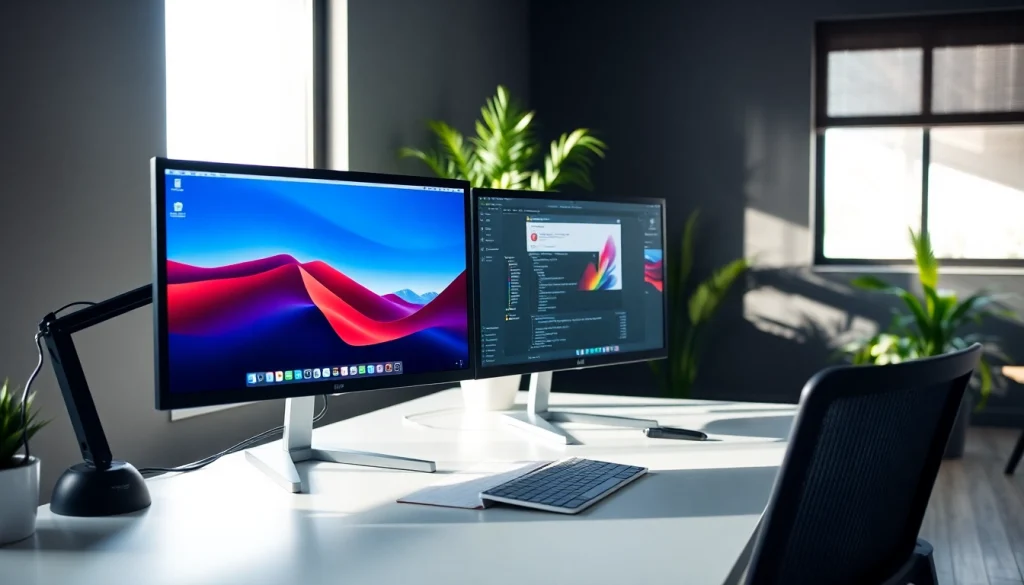Understanding the Benefits of a Dual Monitor Install
In today’s fast-paced digital age, maximizing efficiency and productivity is crucial, especially for professionals whose work demands extensive multitasking. One of the most effective ways to enhance your workspace is by implementing a dual monitor install. This setup offers numerous benefits, from increased productivity to improved workflow efficiency.
1. Increased Productivity
The stark contrast between a single-screen setup and dual monitors is evident in productivity metrics. Research indicates that using two monitors can boost productivity by up to 30%. By having more screen real estate, users can view multiple applications simultaneously without constantly switching back and forth. This seamless navigation leads to more focused work and less time wasted, which can significantly impact overall output.
2. Enhanced Multitasking Capabilities
Multitasking becomes second nature with dual monitors. Users can keep relevant information readily accessible; for example, one monitor could display a report while the other shows a data analysis or communication tools like email and chat applications. This setup helps professionals maintain context and enhances their ability to switch between tasks without losing momentum.
3. Improved Workflow Efficiency
Efficiency in workflow is not just about getting tasks done faster, but also about minimizing errors. Dual monitors allow for a more organized workspace. For designers, developers, or anyone who engages in graphic design, being able to see both the design software and the references side by side streamlines the creative process and leads to faster, more accurate results.
Preparing for Your Dual Monitor Install
Before diving into the installation of your dual monitors, it’s essential to set the stage by preparing adequately. This preparation will save time and prevent potential frustrations during the actual setup.
1. Assessing Computer Compatibility
The first step in preparing for a dual monitor setup is to check if your computer supports multiple displays. This typically involves examining your graphics card and its output ports. Most modern computers will have at least two outputs—HDMI, DisplayPort, or VGA—but it’s vital to ensure these support the resolutions you want to use.
2. Gathering Required Equipment
Once compatibility is confirmed, the next step is to gather all necessary equipment. Essential tools may include:
- Two monitors of your choice
- Appropriate cables (HDMI, DisplayPort, VGA, etc.)
- A suitable stand or mounting hardware (if needed)
- A power strip to accommodate additional plugs
3. Identifying Optimal Monitor Setup
Deciding how to position your monitors is crucial. You could choose to extend your desktop across both monitors or utilize one as a primary display while the other serves as a supplementary screen. Consider factors such as physical space, ergonomics, and your personal workflow habits when making this decision.
Steps for a Successful Dual Monitor Install
Once you have prepared adequately, it’s time to proceed with the installation of your dual monitors. Follow these steps for a smooth installation process.
1. Connecting the Monitors
Start by turning off your computer. Connect the first monitor to your graphics card or docking station, and then connect the second monitor using its respective port. Make sure all cables are secure and that the monitors are powered on.
2. Configuring Display Settings
After connecting the monitors, power on your computer. For Windows users, right-click on the desktop, select “Display settings,” and under the “Multiple displays” dropdown menu, choose either “Extend these displays” or “Duplicate these displays” based on your preference. For macOS users, navigate to System Preferences and select “Displays” to manage your monitor arrangement.
3. Troubleshooting Common Issues
If your second monitor isn’t recognized immediately, don’t panic. First, check all connections to ensure they’re secure. For Windows users, press the Windows key + P to bring up display options; select “Extend” again. For macOS, you may need to adjust the arrangement or resolution settings. If problems persist, updating graphics drivers may resolve compatibility issues.
Optimizing Performance After Dual Monitor Install
With both monitors up and running, optimizing their performance can help maximize efficiency and maintain a smooth workflow.
1. Finding the Right Display Arrangement
Adjust the physical positioning of your monitors to prevent neck strain or eye fatigue. Ideally, the top of the display should be at or just below eye level. Additionally, adjusting the angle towards your main seating position can further enhance comfort and visibility.
2. Adjusting Monitor Resolution and Orientation
Different monitors may have different native resolutions. Ensure both displays have matching resolution settings for a uniform experience. Additionally, some users may find it beneficial to orient one of their monitors vertically—perfect for reading long documents or coding.
3. Utilizing Software for Enhanced Functionality
Several software solutions can enhance two-screen setups. Programs like DisplayFusion and UltraMon allow for further customization of your dual monitor installation, including managing taskbars on both screens, creating custom resolutions, and facilitating smoother window management.
Exploring Advanced Dual Monitor Setups
For those looking to further enhance their dual monitor setup, advanced configurations can provide unique benefits.
1. Multi-Monitor Configurations
Extended setups with three or more monitors are becoming increasingly popular, especially among gamers, traders, and content creators. Each additional screen enhances the user’s ability to multitask and manage various workloads more efficiently. Such configurations do, however, require careful planning regarding space and graphic card capabilities.
2. Customization Options for a Personal Touch
Adding personal touches to your dual monitor setup can improve your workspace aesthetics and overall enjoyment. This might involve custom wallpaper across both screens, unique monitor stands, or even LED lighting to elevate the ambiance of your workspace.
3. Understanding Graphics Card Limitations
Before expanding to more monitors or higher resolutions, it’s crucial to understand the limitations of your graphics card. This hardware essentially dictates how many monitors you can run simultaneously and at what performance level. Be sure to research and choose a graphics card that matches your multitasking needs.
In conclusion, a dual monitor installation not only increases productivity but also enhances multitasking capabilities and overall workflow efficiency. By understanding the preparation, installation steps, performance optimization, and advanced configurations, you can unlock a new level of efficiency in your workspace. Embrace this powerful setup and witness the remarkable improvements it can bring to your daily tasks.


